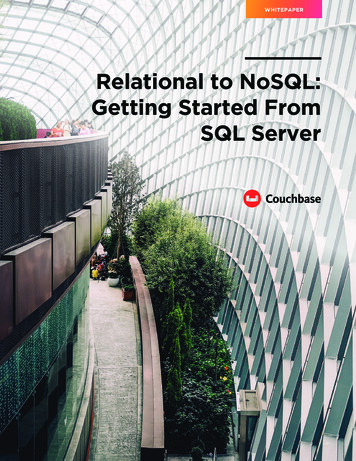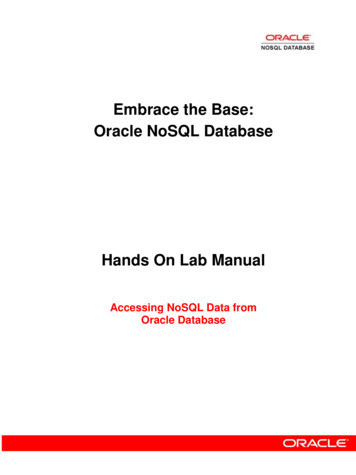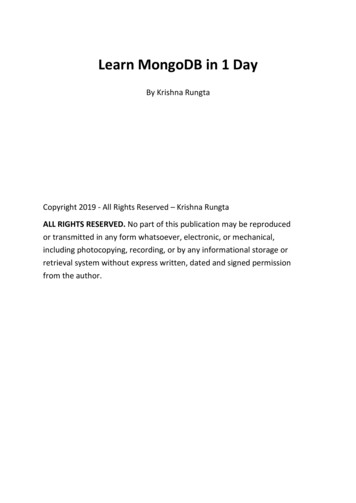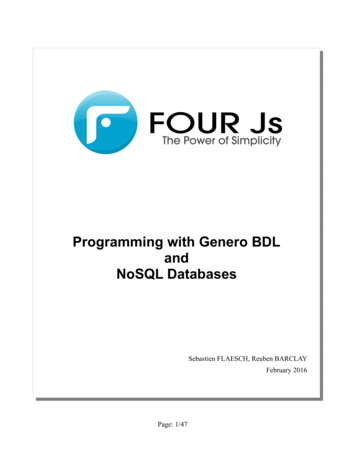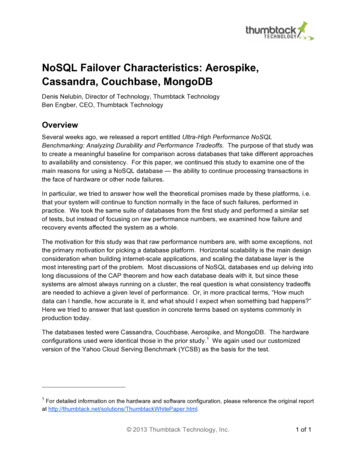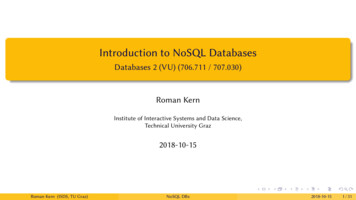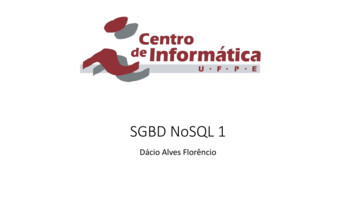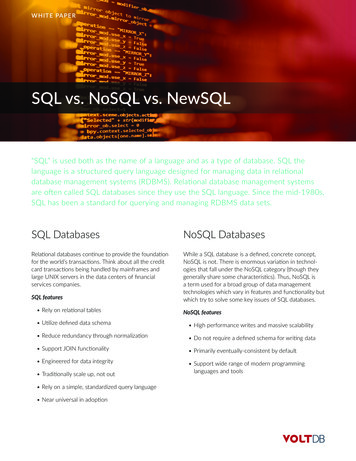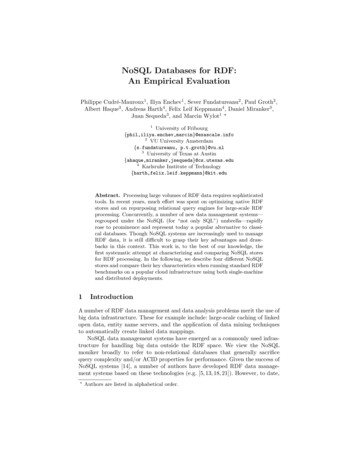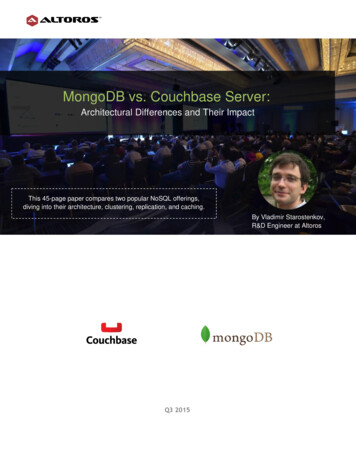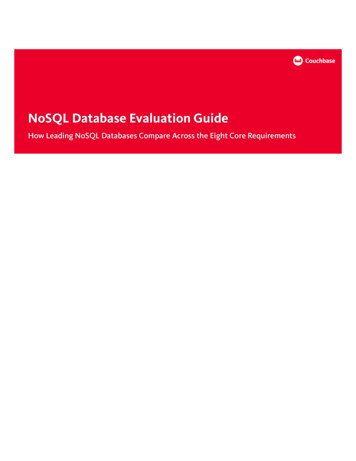
Transcription
NoSQL Database Evaluation GuideHow Leading NoSQL Databases Compare Across the Eight Core Requirements
TABLE OF CONTENTSIntroductionIntroduction2Digital EconomyOverview3Data Access5Performance6Scalability7The business world is undergoing massive change as industry after industry shifts to the DigitalEconomy. It’s an economy powered by the Internet and other 21st-century technologies — thecloud, mobile, social media, and big data. At the heart of every Digital Economy business are itsweb, mobile, and Internet of Things (IoT) applications: they’re the primary way companies interactwith customers today, and how companies run more and more of their business. The experiencesthat companies deliver via those apps largely determine how satisfied — and how loyal —customers will be.Availability8GeographicDistribution9Big Data hecklist13Building and running these web, mobile, and IoT applications has created a new set of technologyrequirements. Enterprise architecture needs to be far more agile than ever before, and requiresan approach to real-time data management that can accommodate unprecedented levels of scale,speed, and data flexibility. Relational databases are unable to meet these new requirements, andenterprises are therefore turning to NoSQL database technology.Three Phases of NoSQL Evolution and Adoption: From Grassroots to MainstreamEnterprise adoption of NoSQL has unfolded in three overlapping phases. In phase I (whichstarted around 2010), developers required flexibility to support the agile development of proofof concepts and small applications. In phase II (which began around 2013), enterprises requiredperformance, scalability, and availability to develop and/or migrate targeted mission-criticalservices. In phase III (which is just starting in late 2015), both developers and enterprises require ageneral-purpose database that combines flexibility, performance, scalability, and availability witha comprehensive query language and powerful indexing to replatform all mission-critical applications and services for the Digital Economy.About this Evaluation GuideThis guide defines and details the eight core requirements for an effective NoSQL database. Basedon those requirements, the guide articulates how databases do or do not meet those requirements, and points out what to look for and what to avoid. It begins with Data Access because thekey requirement for Phase III applications in the Digital Economy is the ability to query data withan expressive language that enables developers to query any type of data independent of how it ismodeled.Criteria2nnData AccessnnMultiple Data CentersnnPerformancennBig Data litynnMobile
The Eight Core Requirements for an Effective NoSQL Database:High-Level OverviewWhile every company has its own specific set of requirements for the NoSQL database technologythat best fits its use case(s), there’s a core set of requirements that figure into most evaluations.Those requirements fall into eight categories, as defined below. This section provides a high-leveloverview of those eight core requirements. Later sections of the guide delve more deeply intoeach core requirement, followed by a comparison of leading NoSQL databases against the full setof requirements.Data AccessAn effective NoSQL database must support the agile development of interactive applicationswith a flexible data model and a comprehensive query language, separating how data is modeledfrom how it is accessed. These capabilities enable architects and developers to create and modifythe data model independent of how the data is queried. The query language must be capable ofexpressing complex queries on nested and/or referenced data with the ability to NEST, UNNEST,and JOIN related data. Ideally, the query language extends SQL, the most powerful, proven, andwell understood of all query languages. In addition, the database should support geospatial andfull-text search, and data processing with MapReduce.PerformanceAn effective NoSQL database must meet the user experience requirements of highly interactiveapplications and the SLAs of mission-critical services with consistent, high performance; efficientuse of memory and persistent storage; asynchronous operations; concurrent reads and writes;and topology-aware clients. To be specific, it must be able to provide low latency read and writeoperations at high throughput. Performance is not only important to the user experience; it alsohas a direct impact on cost and complexity: higher-performance databases require less hardwareand fewer nodes.ScalabilityIn order to support interactive applications with large numbers of users, large amounts of data, orboth — whether from the beginning or as the result of exponential growth — an effective NoSQLdatabase must provide simple, efficient, and reliable scaling on demand and without delay. Itshould require little to no effort to add a single node or many, since the process and effort shouldnot change as the database scales. And it should be possible to scale individual database services(querying, indexing, and storage) separately, in addition to scaling the database as a whole.AvailabilityTo ensure application and/or service uptime, an effective NoSQL database must maintain availability by providing a resilient architecture (i.e., no shared resources, no single point of failure)that leverages networking, topology, smart clients, and replication to survive unplanned outagesand failures, regardless of scope. In addition, online operations such as backing up and restoringdata, and upgrading the database, should be able to be performed while the database remainsonline without requiring any downtime. Finally, the database must be capable of leveraging multiple data centers in such a way that all operations can be immediately rerouted to a different datacenter without a noticeable delay.3
Geographic DistributionAn effective NoSQL database must be able to leverage multiple data centers for high availability,fast disaster recovery, and high performance with local reads and writes. The ability to read andwrite any data to any data center on demand is critical to availability and performance. It notonly enables applications to continue functioning should a data center fail, but it enables them totake advantage of a local database for faster reads and writes. In addition, the database must beflexible enough to support global operations with custom topologies that utilize unidirectionalreplication between some data centers and bidirectional replication between others.Big Data IntegrationAn effective NoSQL database is the foundation of any real-time big data architecture. It must becapable of functioning as both a source and a destination of data by integrating not only withHadoop for long-term storage and offline processing, but also with Spark, Storm, Kafka, Elasticsearch, Solr, and more to enable stream processing, high throughput messaging, distributed fulltext search, and more. While it is important to support batch integration with Hadoop, the newrequirement is streaming integration with platforms like Spark and Storm to enable low-latencyanalytics and iterative machine learning by (a) continuously streaming operational data to themand (b) storing their results so they can be accessed via web and mobile applications.AdministrationAn effective NoSQL database must provide administrators with comprehensive management andmonitoring capabilities via a powerful, full-featured administration console and API while at the sametime automating the processes including, but not limited to, the distribution and replication of data.However, administrators must have the option to perform critical operations on demand with the pushof a button, and without having to take the database offline — including rebalancing data when nodesare added to the cluster. In addition, administrators should be able to perform both cumulative andincremental backups and restores on demand, online, and regardless of node failures.MobileAn effective NoSQL database must provide mobile database capabilities, including fast and consistent access to data, with or without a network connection. With an embedded local databaseand built-in multi-master synchronization, the mobile database must allow all devices to continueto operate while disconnected from the global network. An effective mobile NoSQL solution mustalso provide security for data at rest, data in motion and data in the cloud.4
The Eight Core Requirements for an Effective NoSQL Database:Detailed BreakdownThe following section explains in greater detail each of the eight core requirements for an effective NoSQL database. Each subsection concludes with an at-a-glance checklist of “What to lookfor” and “What to avoid.”Data AccessWHAT TO LOOK FORSQL-Based QueryLanguage with JOINSAn effective NoSQL database must enaable developers to access data in different ways dependingon application requirements and the data, and must have a full-featured query language basedon the database industry standard, SQL. In addition, the database must provide clients in manylanguages from Java to Go and for mobile platforms, too.AggregationIncremental MapReduceSQLNative Full-Text SearchSQL is the proven, de facto industry standard database query language, familiar to all developers.An effective NoSQL database must provide a full-featured query language based on SQL, whichis both expressive and powerful. It enables applications to sort, filter, transform, aggregate, andcombine data with a single query and little to no code. By contrast, databases with proprietaryAPIs or partial query languages lack features such as sorting, aggregation, and joins. These limitations require the application to work with inefficient, possibly ineffective “table per query” or“single table” data models.Elasticsearch and SolrIntegration SupportMapReduceGeoJSONMulti-DimensionalGeospatial IndexesWHAT TO AVOIDProprietary QueryLanguageInability to JOIN DataAn effective NoSQL database must provide incremental MapReduce, which enables applicationsto index, sort, filter, and aggregate data, and to do so faster. With incremental MapReduce, thefirst time a MapReduce function is performed, it processes the existing data and generates results.Then, when new data is added, the database automatically processes the new data and mergesthe new results with the previous results. By contrast, databases that can’t perform MapReduce inincrements must process the entire data set every time, slowing down as the size of the data setgrows.Batch MapReduceTwo-DimensionalGeospatial IndexesUnsupportedElasticsearch and SolrIntegrationGeospatialAn effective NoSQL database must provide geospatial indexes, which enable applications tosearch not only based on location but on any dimension or multiple dimensions, and to search onlocation and multiple dimensions together (e.g., location hours). In addition, a NoSQL databaseshould support standards like GeoJSON, and be flexible enough to support arbitrary coordinatesand numbers. By contrast, a database that’s limited to just two-dimensional geospatial search canonly search based on location. For example, it can find “all restaurants in a city,” but it can’t find“all restaurants in a city that are open after midnight.”Full-Text SearchAn effective NoSQL database should include native full-text search and it should support integration with leading full-text search products like Elasticsearch and LucidWorks/Solr. Without suchintegration support, companies that already have these products installed won’t be able to easilyleverage them.5
PerformanceWHAT TO LOOK FORManagedObject CacheWrite-ThroughCachingIn order to meet high-throughput, low-latency requirements for reads and writes, an effective,high-performance NoSQL database must leverage memory, concurrency, and networking.CachingTopology-AwareClientsA database’s caching architecture has a significant impact on performance. A database with amanaged object cache and write-through caching delivers high performance by storing recentdata in memory and by caching the data of individual reads and writes. By contrast, a databasewith a “block cache” is less efficient: it stores blocks of file data, and blocks may contain the dataof multiple writes — i.e., writes that are not intended to be cached because their data is not beingread. In addition, a database with “read-through caching” requires disk reads, because it does notcache data until it is read.Primaries withReplica icationBidirectionalGeo-ReplicationWHAT TO AVOIDBlock CacheRead-ThroughCachingCoarse-GrainedLockingAn effective NoSQL database should provide fine-grained locking, which can perform many readsand writes at the same time. Each write requires a lock; fine-grained locking capability provides manylocks. By contrast, a database with “coarse-grained locking” limits the number of locks and thereforeis limited to performing just a few writes at a time.ClientsAn effective NoSQL database should provide topology-aware clients, which ensure that all readand write requests require a single hop — from the client to the node. By contrast, if the databasedoes not have topology-aware clients, read and write requests will require multiple hops — fromthe client, to the router/coordinator, to the node.WritesDisk-to-DiskReplicationIn order to perform writes without sacrificing consistency or performance, an effective NoSQL database should enable every node to contain primary and replica data, which utilizes every node.By contrast, databases where nodes contain either primary or replica data (not both) do not efficiently use every node; and databases that rely on quorums to maintain consistency require multiple nodes to perform a write. Both of those approaches negatively impact write icationRouters/CoordinatorsPrimaries withoutReplica DataQuorums6An effective NoSQL database should provide memory-to-memory replication, which does nothave to wait for data to be written to disk before replicating it. This architecture not only improves write performance, but it improves durability when replication is synchronous. An effectiveNoSQL database also enables bidirectional geo-replication, which can replicate data betweenmultiple data centers to improve read and write performance and provide full data locality — applications can read and write any and all data to their data center.
ScalabilityWHAT TO LOOK FORSingle Node TypeAn effective NoSQL database must be highly scalable: Not only should it be able to increasecapacity (data or throughput) or availability by adding nodes, but it should also be able to do soeasily, on demand, and efficiently, by demonstrating linear scaling — i.e., when a node is added, itsfull capacity is added.Flat TopologyTopology-Aware ClientsNodesElastic ServicesAn effective NoSQL database should be based on a single node type and a flat topology, whichmakes scaling easier, faster, and more efficient, because scaling is performed by adding one ormore nodes on demand. In addition, it must be able to be deployed on commodity hardware orcloud infrastructure rather than expensive mainframes or appliances. By contrast, a database withmultiple node types (e.g., primary/secondary/router) and a hierarchical topology is more complexand more difficult to manage: the process requires configuring a group of nodes and adding thatgroup to the cluster. In addition, it may require moving nodes to different servers.Centralized QueryingHeterogeneousHardware SupportedWHAT TO AVOIDServicesMultiple Node TypesHierarchical TopologyRoutersLack of Elastic ServicesAn effective NoSQL database should provide elastic services for data storage, indexing, and querying, which can improve performance and resource utilization by running different services on different commodity hardware — for example, a fast processor is not required for every node, only thoserunning the query service — and also make scaling faster and more efficient. For example, elasticservices make it possible to scale the indexing and querying services to accommodate new featuresand more users without scaling the data storage service. As a result, it’s not necessary to rebalancethe data, or shift it around — a process that can impact overall performance until it is complete.Scatter/Gather QueriesHomogenous HardwareRequiredQueriesAn effective NoSQL database should provide centralized querying, because it scales more efficiently and does not require every node to participate in performing queries. The data may bestored on many nodes for scalability and performance, while the query is performed on a singlenode. It then requests data only from nodes that contain part of the results. By contrast, a database that relies on distributed queries, or “scatter/gather” queries, performs the same query onevery single node, which can slow down queries.ClientsAn effective NoSQL database should provide topology-aware clients, which allows the database tosupport a greater number of clients and applications, because more can be added without changing client configuration or scaling the database. By contrast, a database that relies on routers canrun into issues when every application instance requires a local router and the number of routersoverwhelms the database. If the routers are separated from the application instances, performance drops.7
AvailabilityWHAT TO LOOK FORShared-NothingArchitectureNo Single Pointof FailureMemory-to-MemoryReplicationRack AwarenessPrimary OwnersBidirectional, Cross–Data Center ReplicationFull Write LocalityWHAT TO AVOIDTo deliver high availability, an effective NoSQL database should implement a shared-nothing architecture with replication, rack awareness, replication across multiple data centers, and no singlepoint of failure.ArchitectureAn effective NoSQL database should be designed with a shared-nothing architecture and nosingle point of failure: with this architecture, there are no required nodes and no shared resources between nodes — the database can therefore tolerate the failure of any node or resource. Bycontrast, a database with required nodes (such as routers, proxies, or configuration servers) orwith shared resources (storage, memory, or processors) can lose availability if any of them fail.ReplicationAn effective NoSQL database should include automatic, configurable memory-to-memoryreplication, which ensures availability and consistency while maintaining write performance: thedata is replicated to multiple nodes, and it is fast. If a node fails, the data remains available. By contrast, a database that requires disk IO for replication can only provide one or the other — availabilityand consistency, or write performance.Shared ResourcesConsistencyRequired NodesAn effective NoSQL database should be designed with primary owners, which ensures availabilityand consistency by routing reads and writes of the same data to the same node. While the datais replicated, only a single node needs to be available to perform writes. By contrast, a databasethat relies on quorums requires the majority of quorum members to be available. If not, the databecomes unavailable.Routers/CoordinatorsConfiguration ServersDisk-to-Disk ReplicationQuorumsUnidirectional-OnlyCross–Data CenterReplicationLimited Write LocalityGeographic DistributionAn effective NoSQL database provides bidirectional, cross–data center replication (XDCR) between independent data centers, which ensures availability by enabling applications to read andwrite all data to any data center on demand and without a noticeable delay — all data centers canread and write all data. This capability not only improves availability, but it improves performance— all reads and writes are performed locally — and enables disaster recovery with the ability torecover data from a remote data center. By contrast, a database with only unidirectional replication must perform a failover first — resulting in a temporary loss of availability.ClientsAn effective NoSQL database should provide topology-aware clients, which ensures availabilitybecause clients are aware of node failures. If a node fails, clients will be made aware of it and canroute reads and writes to a different node. By contrast, a database without topology-aware clientsrequires routers or proxies between clients and nodes. If a router or proxy fails, the database canbecome unavailable because the clients cannot reach it. In addition, an effective NoSQL solutionshould provide an embedded database for mobile platforms with built-in, automatic synchronization that is always available, regardless of whether or not the remote database is available.8
Geographic DistributionWHAT TO LOOK FORIn order to deliver high availability, fast disaster recovery, and high performance, an effectiveNoSQL database must leverage cross–data center replication and multiple data centers.Bidirectional ReplicationIndependent ClustersLocalityMemory-to-MemoryReplicationAn effective NoSQL database should provide bidirectional cross–data center replication, whichenables applications to read and write all data to any data center not only for high availability anddisaster recovery, but for performance — applications can perform local reads and writes. By contrast, a database with only unidirectional replication cannot always perform local writes, becauseeither (a) only one data center performs writes, or (b) each data center can only perform writes fora subset of the data.Optimized Cross–DataCenter ReplicationFiltered ReplicationPause/ResumeTopologyData RecoveryAn effective NoSQL database, which provides bidirectional replication between independentclusters, has the flexibility required to support a variety of topologies: ring (sequence of one-toone), hub and spoke (one-to-many or many-to-one in parallel), mesh (many-to-many in parallel),and tiered or mixed combinations. By contrast, a database with bidirectional replication and a singlecluster is limited to a mesh topology; and a database with unidirectional replication and a singlecluster is limited to a hub and spoke topology.WHAT TO AVOIDUnidirectionalReplicationSingle ClusterControlStandard ReplicationAn effective NoSQL database should enable a dedicated cross–data center replicationimplementation, which not only provides advanced functionality, but is also easier to manage.Administrators can pause, resume, or cancel replication on demand; configure filtering to limitreplication based on application, tenant, geography, and more; and use it to perform datarecovery. By contrast, a database that relies on standard replication, without dedicated cross–data center replication, provides limited functionality and is difficult to manage because it is notseparate from intra-cluster replication.Full Replication OnlyReplicationIn order to reduce replication latency and thus the window of inconsistent data, an effectiveNoSQL database should use memory-to-memory replication to avoid disk IO. By contrast, adatabase with disk-to-disk replication can suffer from large windows of inconsistent data, becauseit has to wait for data to be written to disk before replicating it.9
Big Data IntegrationWHAT TO LOOK FORAn effective NoSQL database must support integration with big data, analytics, and reportinginfrastructure with both batch and streaming data flows.Certified Sqoop PluginSpark Input/OutputHadoopSpark SQL InputIn order to import data from and export data to Hadoop, an effective NoSQL database shouldprovide a certified Sqoop plugin. By exporting data to Hadoop, data can be processed by multipleMapReduce or Spark jobs — i.e., the data is in Hadoop. By contrast, a database that relies on aMapReduce input source forces Hadoop to ingest all of the data every time a job is run — i.e., thedata remains in the database.Spark Streaming InputKafka Consumer andProducerODBC/JDBC DriversSparkSQL-Based QueryLanguageAn effective NoSQL database should provide complete Spark integration, enabling the database tobe used as a source of data for Spark, Spark Streaming, and Spark SQL, in addition to being used topersist the results. By contrast, a database that’s limited to Spark and Spark SQL integration can beused as an input and/or output source for offline analytics, but it can’t be used as an input for SparkStreaming for real-time analytics.WHAT TO AVOIDNo Sqoop PluginNo Spark SQL InputKafkaNo Kafka IntegrationAn effective NoSQL database should provide complete Kafka integration, which enables thedatabase to be used as a producer (source of messages) and/or consumer (destination of messages). When the database is used as a producer, data is published to a message queue as soon as it iswritten to the database. When the database is used as a consumer, data is written to the databaseas soon as it is published to the message queue.No Supported Full-TextSearch IntegrationETL/BI/ReportingNo SparkStreaming InputNo SQL-Based QueryLanguage10An effective NoSQL database should come with standard, full-featured ODBC/JDBC drivers anda query language based on SQL that can be used with analytics and data integration tools withoutrequiring a custom connector or adapter. By contrast, a database without ODBC/JDBC drivers,or with drivers that do not wrap a SQL-based language, provides limited functionality and performance because it has to implement query logic within the driver.
AdministrationWHAT TO LOOK FORManual RebalancingOn-Demand BackupsOperations viaAdmin ConsoleCumulative andIncremental Backupand RestoreConfiguration UI200 MetricsCluster-Wide LogAggregationOnline RestoreWHAT TO AVOIDNo Manual RebalancingAn effective NoSQL database should give administrators access to a complete administrativeconsole and API that provides them with all the tools necessary to easily manage and monitordeployments of any size and scale.ManagementAn effective NoSQL database should provide a full-featured administration console and APIgiving administrators complete control of all database operations — including the ability to addor remove nodes, rebalance data, perform backups, restore data, failing over nodes, restore failednodes, and more — all on demand. By contrast, databases with limited administration consolesrequire administrators to perform some tasks manually, either by editing configuration files orperforming command line operations, or in some cases by performing tasks automatically withoutthe option for administrative control.MonitoringA critical part of managing both small and large deployments is a full complement of statistics anddata for monitoring. An effective NoSQL database must therefore give administrators access to hundreds of metrics, both cluster-wide and node-specific. By contrast, a database with limited metricsmay not provide administrators with information such as swap usage, CPU utilization, the number ofconnections, disk reads per second, the percent of data resident in memory, replication queue size,geo-replication status, and much more.Backup/RestoreNo On-Demand BackupsOperations viaCommand LineScheduled BackupsConfiguration FilesLimited MetricsPer-Node Log AnalysisSnapshot Backupand RestoreOffline Restore11In order to efficiently restore the data of a cluster, an effective NoSQL database must enableadministrators to perform cumulative and incremental backups and restores. This includes takingcumulative and incremental backups, as well as restoring data from cumulative or incrementalbackups. By contrast, a database that’s limited to snapshots forces administrators to restore allof the data, even if only a small percentage of it needs to be restored. In addition, administratorsshould be able to perform backups on demand, as well as restore data regardless of whether ornot nodes have failed.
Mobile DatabaseWHAT TO LOOK FORAn effective NoSQL database must provide mobile database capabilities, including fast and consistent access to data, with or without a network connection.Offline Data AccessFlexible Data ModelLocal DatabaseFast QueriesChange EventsAn effective mobile NoSQL solution must provide an embedded database that runs on the deviceand has a small footprint. The database must provide a flexible data model, perform fast queriesagainst data, and publish change events that allow applications to listen/observe for data rityAn effective mobile NoSQL solution must provide built-in multi-master synchronization that allowsfor secure synchronization between local and remote databases. It should support flexible deployment topologies — including Star, Tree, and Mesh — and allow different parts of the system (inaddition to the devices) to operate while disconnected from the global network.ManagedSynchronizationSecurityFlexible DeploymentTopologyWHAT TO AVOIDAn effective mobile NoSQL solution must provide security for customizable user authentication,fine-grained data read/write access, data transport over a secure channel, encrypted data storageon device, and encrypted data storage in the cloud.Reliant on NetworkInflexible Data ModelKey/Value OnlyPolling for ChangesCache and Write QueuesOnly Support forStar TopologyDIY SecurityDIY SynchronizationConclusion12The process of evaluating a NoSQL database begins with identifying its architecture and understanding its features, both the capabilities and the limitations. The architecture and featureshave to meet developer, enterprise, and application requirements. If they do, the next step is toperform a hands-on evaluation — install the database, build a proof of concept or migrate a simpleapplication, and see how well it does or does not perform under load.
Appendix A: NoSQL Database Evaluation ChecklistThe following checklist evaluates Couchbase Server, MongoDB, and Cassandra (DataStax Enterpri
tive NoSQL database. Each subsection concludes with an at-a-glance checklist of "What to look for" and "What to avoid." Data Access An effective NoSQL database must enaable developers to access data in different ways depending on application requirements and the data, and must have a full-featured query language based
